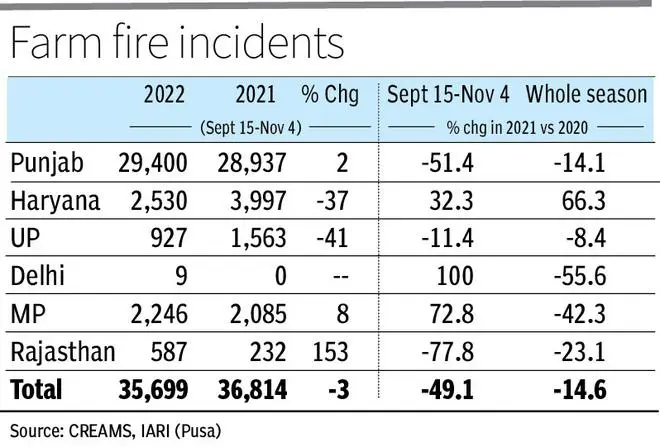Even as Delhi’s air quality deteriorated sharply over the last few days, it has emerged that stubble burning in Punjab have increased by 2 per cent over the September 15-October 5 2022 period, compared to the same period last year. Punjab accounted for 82 per cent of 35,699 cases recorded by Indian Agricultural Research Institute (IARI) this year.
Stubble burning incidents in Haryana, which witnessed a sharp rise last year, have declined 37 per cent over the same period this year, with the State witnessing 2,530 cases of farm fires, accounting for 7 per cent of the cases. Madhya Pradesh, with 2,246 cases this year, recorded a jump of 8 per cent over the year-ago period.

Why Haryana fares better
One reason why farmers in Haryana seem to be better at managing their stubble compared to their counterparts in Punjab is that some have found buyers for their residue. “We are earning a profit of ₹1,000/acre after some buyers showed interest in the paddy residues. Earlier there was no takers and farmers did not want to spend an extra ₹4,000/5,000 per acre (for disposal),” Ashok Dahiya, a farmer in Haryana’s Sonipat district, said.
He said he sold his stubble for ₹6,000-8,000/acre which helped him to recover the hiring charges of labour and also left him some profit. In Palwal (Haryana), farmers like Yudhistir Sharma are earning even more -- up to ₹3,000/acre -- from their stubble.
“There is a big demand for stubble for cattle feed and buyers are coming from Mewat region, which is famous for livestock rearing, and paying ₹8,000-9,000/acre depending on the quality of crop residues,” Sharma said, adding that they save ₹2,000-3,000/acre after paying labour charges.
Farmers from Punjab have not had such luck. Many are actually waiting for someone to pick up the stubble from their fields free of cost. “We hear and read about companies procuring paddy residues, but none has come to our village. Nor are decomposers available,” said Amrik Singh, a farmer in Ludhiana district.
Addressing two problems
The air quality during winter will continue to suffer year after year until Punjab government shows a desire to solve it, said Vijay Sardana, a food policy analyst. Suggesting court intervention in the matter, Sardana said there is a need to change the design of harvesters and to allow Food Corporation of India (FCI) to procure alternative crops in place of paddy from Punjab.
He also demanded that free power for paddy should be stopped. “This will address two problems -- air pollution of Delhi and North India and the water table of Punjab. Unfortunately, Punjab has no action plan except demanding more taxpayers’ money from the Union government,” Sardana added.
It is a larger issue and there is no simple solution, believes IARI director AK Singh. “Apart from in-situ management, using happy seeder and similar equipment, using residue as raw material for power generation and using PUSA decomposer, there can be some policy intervention required,” he said.
This year, the early sowing of wheat in some States has also led to an increase in farm fires incidents compared to last year, said a scientist involved in monitoring the incidents. A clear picture will emerge after the end of this month whether there will be reduction in such incidents or not, he added.
Latest official data show wheat has been planted in nearly 5 lakh hectares in Madhya Pradesh and Rajasthan against none until November 3 last year, whereas in UP sowing areas have doubled. In Punjab and Haryana wheat is yet to be sown.
“If 130 days duration paddy varieties (already available) are sown, it will give enough time to farmers to sow wheat after harvesting the paddy crop,” AK Singh said. “Farmers need a gap of at least 10-15 days between the paddy harvest and planting of wheat, and it is a challenge for scientists to develop shorter duration varieties of paddy and wheat without compromising on yield,” he said.
Delhi Chief Minister and Aam Aadmi Party (AAP) supremo Arvind Kejriwal’s statement owning responsibility and asking for time to curb the problem, seems to be public posturing since he made it clear that “farmers are not responsible for it and they will stop burning ‘parali’ the day they have a solution.”
Collective responsibility
The comparative data on stubble burning varies by the day, and a clear picture will only emerge at the end of the season. For instance, the increase in stubble-burning cases in Punjab was 13 per cent up to November 4 this year, and it came down to 2 per cent up to November 5. Similarly, in Madhya Pradesh, until November 4 last year there was 73 per cent rise in cases whereas at the end of the season there was 42 per cent fall.
At a workshop on November 4 in Delhi for better and optimum utilisation of PUSA decomposer by farmers, Union Agriculture Minister Narendra Singh Tomar said that proper management of paddy stubble is the collective responsibility of all to prevent pollution. He said a comprehensive solution to this problem is possible with the optimum utilisation of 2.07 lakh machines made available to the States for stubble management with the assistance provided by the Centre.





Comments
Comments have to be in English, and in full sentences. They cannot be abusive or personal. Please abide by our community guidelines for posting your comments.
We have migrated to a new commenting platform. If you are already a registered user of TheHindu Businessline and logged in, you may continue to engage with our articles. If you do not have an account please register and login to post comments. Users can access their older comments by logging into their accounts on Vuukle.